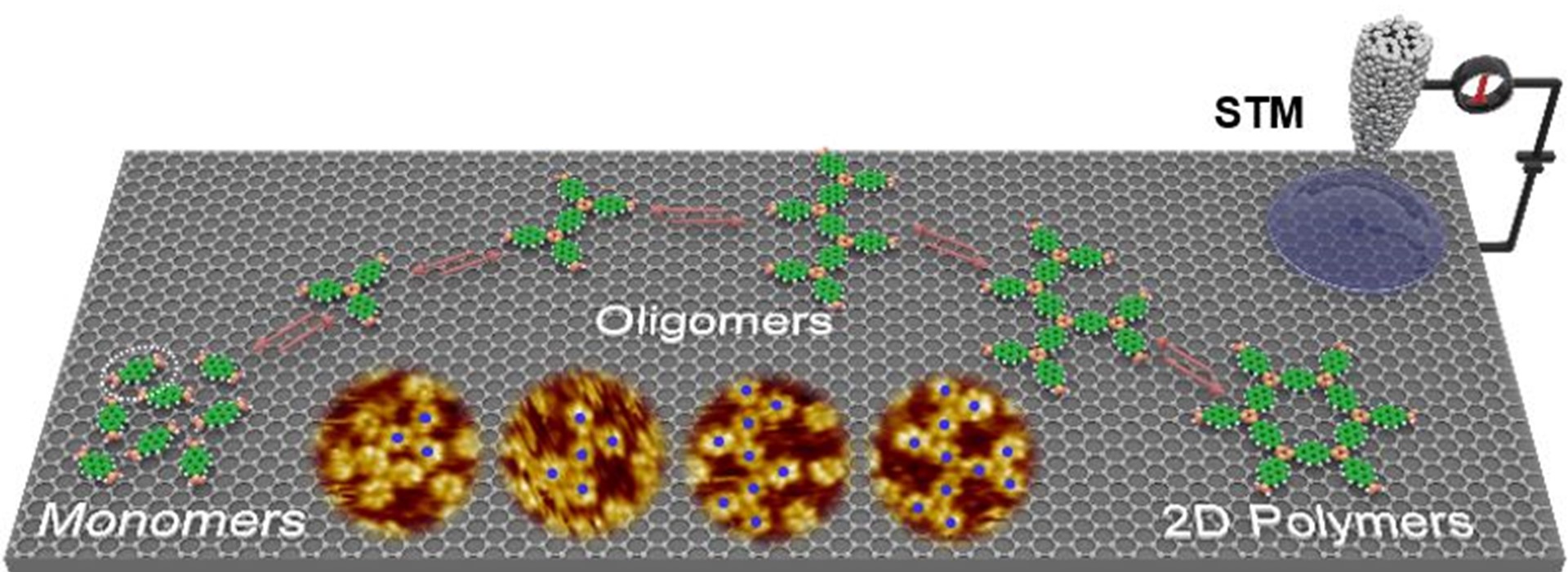Observing polymerization in 2D dynamic covalent polymers

For the expert: We characterize a model boroxine 2D dynamic covalent polymer, by using in situ scanning tunnelling microscopy, to unveil both qualitative and quantitative details of the nucleation–elongation processes in real time and under ambient conditions. Sequential data analysis enables observation of the amorphous-to-crystalline transition, the time-dependent evolution of nuclei, the existence of ‘non-classical’ crystallization pathways and, importantly, the experimental determination of essential crystallization parameters with excellent accuracy, including critical nucleus size, nucleation rate and growth rate. The experimental data have been further rationalized by atomistic computer models, which, taken together, provide a detailed picture of the dynamic on-surface polymerization process. Furthermore, we show how 2D crystal growth can be affected by abnormal grain growth. This finding provides support for the use of abnormal grain growth (a typical phenomenon in metallic and ceramic systems) to convert a polycrystalline structure into a single crystal in organic and 2D material systems.
Read more?
Gaolei Zhan, Zhen-Feng Cai, Karol Strutyński, Lihua Yu, Niklas Herrmann, Marta Martínez-Abadía, Manuel Melle-Franco, Aurelio Mateo-Alonso Steven De Feyter Observing polymerization in 2D dynamic covalent polymers Nature, 2022 https://www.nature.com/articles/s41586-022-04409-6
"Eerst zien, dan geloven"
Prof. Steven De Feyter van de KU Leuven (België) heeft samen met medewerkers Dr. Gaolei Zhan, Dr. Zhen-Feng Cai, Drs. Lihua Yu, en Drs. Niklas Herrmann, en onderzoekers van de Universiteit van Baskenland (Prof. Aurelio Mateo-Alonso, Dr. Marta Martínez-Abadía) en de Universiteit van Aveiro (Prof. Manuel Melle-Franco, Dr. Karol Strutyński), een artikel gepubliceerd in Nature met momentopnames van de vorming en groei van tweedimensionale (2D) polymeren, en dit met moleculaire resolutie.
We kunnen ons geen leven zonder polymeren meer voorstellen. Producten gemaakt van polymeren komen overal om ons heen voor, zoals kleding gemaakt van synthetische vezels en kunststoflenzen in brillen. Polymeren worden gevormd wanneer kleine moleculen, monomeren, aan elkaar worden gekoppeld om lange ketens te vormen. Als een monomeer met meer dan twee andere monomeren reageert, kunnen ultradunne polymeervellen met een periodieke interne structuur worden gevormd. Dit zijn de 2D polymeren. Sommige van deze 2D polymeren zijn poreus en kunnen worden gebruikt als membranen. Andere soorten zijn veelbelovend voor geavanceerde elektronica. Hoe deze 2D polymeren precies gevormd worden, bleef echter een mysterie. Het is belangrijk om hun vormingsmechanisme te kennen om de grootte en structurele perfectie van deze interessante materialen te vergroten.
Daarom hebben een team van de KU Leuven (België), POLYMAT en de Universiteit van Baskenland (Spanje), en de Universiteit van Aveiro (Portugal) de krachten gebundeld om inzicht te verschaffen in de mechanistische en kinetische aspecten van deze reacties die leiden tot de vorming van 2D polymeren. Zij hebben gebruik gemaakt van rastertunnelmicroscopie (STM), een geavanceerd type van niet-optische microscopie, om in real-time, terwijl bindingen zich vormen en breken, molecuul voor molecuul, de geboorte en groei te volgen van deze 2D polymeren op een vaste drager ondergedompeld in een reactieve oplossing. Verder ondersteund door computermodellen toonden zij aan dat verschillende groeimechanismen naast elkaar bestaan en dat de beheersing daarvan leidt tot de vorming van polymeervellen met grote afmetingen van hoge kwaliteit.
Het onderzoek in de De Feyter groep aan het Departement Chemie (www.defeytergroup.org) richt zich op moleculen en oppervlakken. Om hun verlangen naar "eerst zien, dan geloven" te bevredigen, gebruiken zij speciale soorten microscopen, namelijk rastersondemicroscopen, om de schoonheid en functie van moleculaire assemblages op oppervlakken te ontrafelen. Bovendien modificeren zij oppervlakken met innovatieve chemische methodes. Ongeacht de functionaliseringsaanpak die zij ontwikkelen, is nanostructurering het sleutelwoord: zij richten zich op het ruimtelijk controleren van de organisatie van moleculen op oppervlakken, met moleculaire precisie, met als doel de functionaliteit te beheersen. Deze expertise bleek van cruciaal belang voor de synthese van 2D polymeren op oppervlakken en voor het onderzoek naar hun vorming in real-time met moleculaire resolutie.
“Seeing is believing”
The group of Professor Steven De Feyter at KU Leuven (Belgium), involving Dr. Gaolei Zhan, Dr. Zhen-Feng Cai, Drs. Lihua Yu, and Drs. Niklas Herrmann, in collaboration with researchers from the University of the Basque Country (Prof. Aurelio Mateo-Alonso, Dr. Marta Martínez-Abadía) and the University of Aveiro (Prof. Manuel Melle-Franco, Dr. Karol Strutyński), have published an article in Nature that provides literally snapshots of the formation and growth of 2D polymers with submolecular resolution.
We can no longer imagine life without polymers. Products made of polymers are all around us, ranging from clothing made from synthetic fibers, to plastic lenses in glasses. Polymers are formed when small molecules called monomers are linked together to form long chains. If a monomer reacts with more than two other monomers, sheets with a periodic internal structure can be formed, called two-dimensional (2D) polymers. Some of these 2D polymers are porous and could be used as membranes. Other types are promising for advanced electronics. How these 2D polymers are exactly formed remains a mystery. It’s important to know though their formation mechanism to boost the size and structural perfection of these interesting materials.
Therefore, the teams from KU Leuven (Belgium), POLYMAT and the University of the Basque Country (Spain), and the University of Aveiro (Portugal) have joint forces to provide insight in the mechanistic and kinetic aspects of these reactions leading to the formation of 2D polymers. They used scanning tunnelling microscopy, an advanced type of non-optical microscopy, to follow in real-time, as bonds form and break, molecule by molecule, the birth and growth of these 2D polymers on a solid support immersed in a reactive solution. Supported and rationalized by computer models, they showed that several growth mechanisms co-exist and controlling them leads to the formation of high-quality large-size polymer sheets.
To enable comments sign up for a Disqus account and enter your Disqus shortname in the Articulate node settings.


